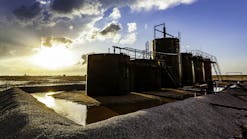Q: With the ever-increasing cost of oil and resulting increases in the cost of power, what can be done to decrease the operating cost of existing pump systems? A: With existing pump systems, the most cost-effective change that can be made is converting to variable-speed drives for your pumps. At the same time, existing control valves must be removed. The result will be a reduction in the head loss in the system and lower operating speed for the pumps (Figure 1). If you do the math, you should see a one- or two-year payback on the cost of conversion. Other opportunities for power savings include: • Maintain pumps close to new condition to avoid efficiency loss. • Don’t allow for excess margin in rate of flow or head. • Review the pump selection and use a more efficient pump design if possible. • Use two or more smaller pumps instead of one larger pump so that excess capability can be turned off. • Use pumps operating as turbines to recover pressure energy that would otherwise be wasted. The Hydraulic Institute publishes an education program on this subject titled Energy Reduction in Pumps and Pumping Systems. Visit the e-Store at www.pumps.org for details. Q: We are converting several vertical turbine pumps to the submersible type. Are there any special installation requirements that we should be aware of? A: Yes. One is the need for room for the power cable that must be attached to the outside of the pump column pipe. The clearance between the pump column pipe and the well casing must be ample to avoid damage to the cable.. The joints between the column pipe sections will probably present the biggest challenge. In addition, the couplings for the discharge pipe joints must be tightened securely to prevent the motors induced starting torque from either loosening or further tightening the joints. This would cause the power cable to spiral around the pipe and could cause cable or terminal failure. When the unit has been completely installed, a megger (meg-ohm meter) reading should be taken on the cable/motor per the manufacturer’s instructions to verify complete electrical integrity. If the megger reading is below the manufacturer’s recommended minimum, the problem must be identified and corrected before the unit is started. See ANSI/HI 2.4 Vertical Pumps for Installation, Operation and Maintenance for more details. Q: What special design features should we look for when purchasing nonclog pumps for wastewater service? A: Nonclog pumps are recommended for handling raw or unsettled sewage, activated sludge, industrial wastewaters containing solids and similar liquids where excessive clogging would otherwise be encountered. The largest solid sizes that the pump will be required to handle in normal operation must be specified. The term "sphere size" denotes the largest diameter ball that can be passed through the pump. The smaller pumps begin at three-inch discharge opening and can handle two-inch diameter solids. The impellers are wider than normal and usually are designed with two or three vanes. Comminutors for cutting large solids and/or bar screens must be provided to prevent larger solids from entering the pump. In addition, inspection openings in the casing or adjacent piping are recommended for access to the impeller in the event that clogging does occur. More information can be found in ANSI/HI 1.3 Centrifugal Pumps for Design and Application.

